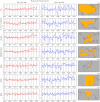Perception of climate change
- PMID: 22869707
- PMCID: PMC3443154
- DOI: 10.1073/pnas.1205276109
Perception of climate change
Abstract
"Climate dice," describing the chance of unusually warm or cool seasons, have become more and more "loaded" in the past 30 y, coincident with rapid global warming. The distribution of seasonal mean temperature anomalies has shifted toward higher temperatures and the range of anomalies has increased. An important change is the emergence of a category of summertime extremely hot outliers, more than three standard deviations (3σ) warmer than the climatology of the 1951-1980 base period. This hot extreme, which covered much less than 1% of Earth's surface during the base period, now typically covers about 10% of the land area. It follows that we can state, with a high degree of confidence, that extreme anomalies such as those in Texas and Oklahoma in 2011 and Moscow in 2010 were a consequence of global warming because their likelihood in the absence of global warming was exceedingly small. We discuss practical implications of this substantial, growing, climate change.
Conflict of interest statement
The authors declare no conflict of interest.
Figures










Comment in
-
A new face for climate dice.Proc Natl Acad Sci U S A. 2012 Sep 11;109(37):14720-1. doi: 10.1073/pnas.1211721109. Epub 2012 Aug 20. Proc Natl Acad Sci U S A. 2012. PMID: 22908281 Free PMC article. No abstract available.
-
Frequent summer temperature extremes reflect changes in the mean, not the variance.Proc Natl Acad Sci U S A. 2013 Feb 12;110(7):E546. doi: 10.1073/pnas.1218748110. Epub 2013 Feb 5. Proc Natl Acad Sci U S A. 2013. PMID: 23386728 Free PMC article. No abstract available.
-
Inferring the anthropogenic contribution to local temperature extremes.Proc Natl Acad Sci U S A. 2013 Apr 23;110(17):E1543. doi: 10.1073/pnas.1221461110. Epub 2013 Mar 19. Proc Natl Acad Sci U S A. 2013. PMID: 23513228 Free PMC article. No abstract available.
-
Reply to Rhines and Huybers: changes in the frequency of extreme summer heat.Proc Natl Acad Sci U S A. 2013 Feb 12;110(7):E547-8. doi: 10.1073/pnas.1220916110. Proc Natl Acad Sci U S A. 2013. PMID: 23530273 Free PMC article. No abstract available.
-
Reply to Stone et al.: Human-made role in local temperature extremes.Proc Natl Acad Sci U S A. 2013 Apr 23;110(17):E1544. doi: 10.1073/pnas.1301494110. Proc Natl Acad Sci U S A. 2013. PMID: 23745185 Free PMC article. No abstract available.
References
-
- Rabe BG, Borick CP. Issues in Governance Studies. Washington, DC: Brookings Institution; 2012. Fall 2011 national survey of American public opinion on climate change.
-
- Hansen J, et al. Target atmospheric CO2: Where should humanity aim? Open Atmos Sci J. 2008;2:217–231.
-
- Hansen J, et al. Global climate changes as forecast by Goddard Institute for Space Studies 3-dimensional model. J Geophys Res Atmos. 1988;93:9341–9364.
-
- Solomon S, et al., editors. Intergovernmental Panel on Climate Change (IPCC) Climate Change 2007: The Physical Science Basis. New York, NY: Cambridge press; 2007.
-
- Hansen J, Ruedy R, Sato M, Lo K. Global surface temperature change. Rev Geophys. 2010;48:RG4004.
Publication types
MeSH terms
LinkOut - more resources
Full Text Sources
Other Literature Sources
Medical
Molecular Biology Databases
Miscellaneous

